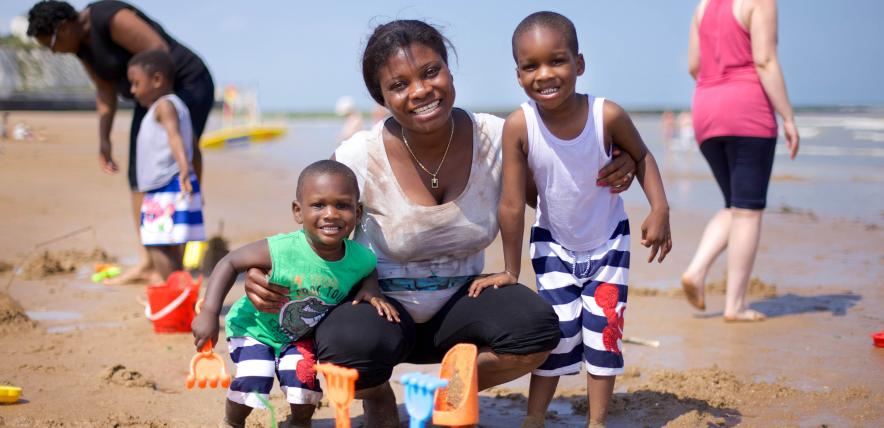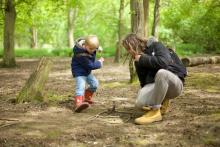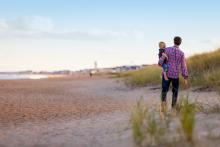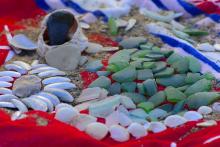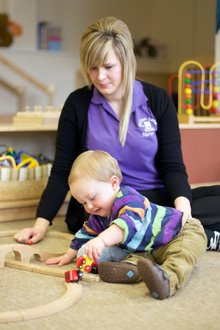The seaside is the ultimate sensory learning environment, full of fascinating things to see, feel, smell, hear and taste. Your child probably won't think of a seaside visit as educational though – they'll be far too busy having fun!
Sun, sea and sand
On a sandy beach, your little one will probably be stamping out a trail of footprints or digging to Australia before you've even put your bags down. Once they've mastered a simple sandcastle, it's time to get more ambitious. How about an elaborate fortress, complete with moat and shell decorations? Or two fortresses, heavily fortified – which one will the incoming tide knock down first?
Pile the sand over your child's legs and shape it into a beautiful mermaid's (or merman's) tail or racing-car. Or try making a sand sculpture of a dragon, turtle or spaceship. Bring a toy digger or two and create a sandy construction site. Or, if your child prefers demolition, take it in turns to remove a spadeful of sand from the bottom of a sandcastle. Whoever knocks it down gets splashed with cold seawater!
Flat, damp sand is a perfect canvas for large-scale writing and drawing with sticks, stones or spades. Help your child write their name in giant letters, or make funny faces for your shadows. Mark out a hopscotch grid, or a target for playing shell-toss. Or how about a stick-and-sand game of noughts and crosses, hangman or Pictionary?
Flat, damp sand is also an ideal base for some beach gymnastics, barefoot running or boules. And what better place than a sandy beach to introduce your child to volleyball, frisbee or kite-flying?
On the rocks
Low tide is the time to explore rockpools. Wear non-slip water-resistant shoes and take some see-through containers with you, perhaps with a magnifying glass and spotter's guide too. The National Trust advises against using nets, as they can damage delicate marine creatures.
If a pool seems empty, peek under rocks, especially in shady spots, or have a gentle dig in the sand at the bottom to see if anything is hiding below. Look out for shore crabs, hermit crabs, prawns, starfish, and anemones with colourful tentacles. If you're lucky, you might find a little fish, most likely a blenny or goby. After examining your finds, make sure you put them back where you found them. Then look out for barnacles, limpets and sea-snails as you clamber back over the rocks.
If there's a sea wall or jetty, have a go at crabbing. Put some bacon into a net washing-tablet bag, tie it to a string or fishing line, and drop it down to the sea floor to see if a crab bites. If it does, lift it carefully and place it in a bucket of seawater to examine it, before popping it back into the sea.
Treasure trove
Whether the beach is sandy, shingly or stony, it's likely to be full of interesting things for your child to discover. The best place to look is along the strand-line, where debris is washed up at high tide, and the best time is after a storm. Search for shells, interesting pebbles (can your child find one with a hole in, or a flat one for skimming?), seaweed, driftwood, feathers, egg sacs from sharks or rays, and nuggets of glass worn smooth by the ocean. Take a bucket or bag for collecting your finds.
Try a scavenger hunt, giving your child a list of things to search for. Or pretend to be pirates and dig deep to see what buried 'treasure' you can find.
Your child might fancy turning their shoreline finds into a piece of beach art. Press them into the damp sand to make a picture of a favourite sea creature, abstract pattern or self-portrait. Then photograph your creation before it's destroyed by the tide and tourists.
Shells are a timeless source of fascination to young children. They may want to sort them by size, colour, texture or type, examine their patterns, or find out what sort of creature they've come from. Take some home and try doing shell rubbings with wax crayon (scallop shells work best for this), pressing them into play-dough to make patterns, or using them to decorate picture frames or boxes.
What better way to end a day at the beach than with a seaside storybook? Magic Beach by Alison Lester, Lucy and Tom at the Seaside by Shirley Hughes, Sharing a Shell by Julia Donaldson and Lydia Monks or At the Beach by Roland Harvey will gently ease your little one from beach-time to bedtime.
Seaside safety tips to remember
As well as lots of opportunities for fun and learning, a trip to the beach brings risks and hazards. Follow these tips to help your family stay safe:
- Beaches can be crowded, confusing places, so make sure your child knows not to go with anybody else and what to do if they get lost. Write your mobile number inside their beach shoes or on a wristband and rehearse showing it to a safe adult and asking for help if they get separated from you. Point out eye-catching things around you to help them find their bearings.
- Supervise children at all times. If there's more than one adult in your party, take it in turns to have relaxation time and child-watching time.
- If you want to swim, the safest place is on a lifeguard-patrolled beach between the red-and-yellow flags. Never swim if you see a red or black-and-white chequered flag.
- Watch out for currents and high winds, especially if swimming or using dinghies or boogie boards. Don't use inflatables if an orange wind-sock is flying.
- Look out for stinging jellyfish and weaver fish.
- Look out for dangers such as broken glass, syringes or dog mess.
- Take plenty of drinking water and keep everyone well hydrated.
- Use a high-factor, waterproof sunscreen on the whole family, and reapply it regularly.
- Protect your child from the sun using a hat, shades, a UV suit or T-shirt and perhaps a UV-tent too. Try to keep them in the shade in the middle part of the day.
- Take a first-aid kit with treatments for cuts, stings and insect bites.
- Don't get caught out by incoming tides. There are websites where you can check tide times before your visit.
- Make sure your child knows not to climb into tunnels in the sand, or holes deeper than their waist. And fill in any holes before you leave.
- Remember that children can drown in even a few inches of water so must be supervised carefully even if paddling at the water’s edge.
Written for the Early Years Alliance by Elyssa Campbell-Barr.

